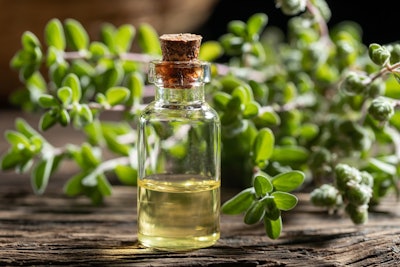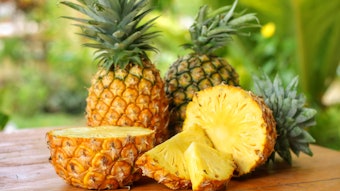
I’d like to mention a bit of a diversion from the normal way in which I present materials for review and presentation to you. In two sets of instances, the panel compared a few isomers. Then we looked at two different botanical species of oil. Read on for all the insight! Please let me know if this is something you love or detest.
cis-3-Hexenyl salicylate
Source: M&U
FEMA# 4750 CAS# 65405-77-8
Naturally occurring: Cornmint, mango.
Odor @ neat: Sweet, green, light, fruit skin, plastic, fleshy, vegetative, herbal, phenolic, anisic, heavy, rubbery, creamy, tropical, background cooling.
Taste @ 2 ppm: Green, fleshy, slight plastic, waxy, skin, mango flesh, burnt, heavy mouthfeel, creamy, anisic, spicey, pear, green rindy.
Taste @ 5 ppm: Bitter, plastic, green, slight floral, mango, pear, cucumber, melon, was too high for some. Very impactful compound.
Possible applications: Some found this to be helpful for rhubarb, mango, passionfruit, guava to help define the skin notes. If we consider other rind and skin notes, the panel suggested cucumber, melons and some savory herbs which would include perilla leaf, cumin, thyme and oregano. There seems to be a charred or burnt impact at higher dosages; the panel suggested burnt garlic and smoke profiles. As always, dose is of the utmost importance.
 The neryl acetate sample reminded some panelists of the flavor profile of Turkish delight.YuliiaMazurkevych at Adobe Stock
The neryl acetate sample reminded some panelists of the flavor profile of Turkish delight.YuliiaMazurkevych at Adobe Stock
Neryl acetate, natural
Source: Avant Organics
FEMA# 2773, CAS# 141-12-8
Naturally occurring: Black currant, buchu, cardamom, celery, bergamot, bitter orange peel, Budda hand oil, grapefruit oil, kumquat, lemon, lemongrass, lime, mandarin, orange, pomelo, yuzu, clary sage.
Odor @ neat: Bright, fresh, lemony, slight floral, black pepper, sweet, bergamot, slight citrus, green, rosy, terpenic, piney, vegetal, candied, sweet.
Taste @ 1 ppm: A bit low, slight citrus, oily, lemon, light, juicy, celery, powdery.
Taste @ 2 ppm: Slightly soapy, green, citrus, floral, peel, fruit punch, piney, black pepper, heavy, floral, rose, oily, green pepper skin.
Possible applications: This cis-isomer really finds its home in citrus profiles to lend a bright, and almost waxy and tropical nuance. Turkish delight was mentioned as a flavor profile and to be honest, I needed to look it up and found it’s made with bergamot and/or lemon oils with rose water. So, that sounds completely correct. However, the panel also thought that this is very worthy to add to blackberry, blueberry and raspberry profiles as well as peach, apple and mangoes, or even fruit punches. Some felt that broccoli and peppers (chili and black) would benefit from a touch.
Geranyl acetate, natural
Source: Avant Organics
FEMA# 2509, CAS# 105-87-3
Naturally occurring: Apple, chamomile, cardamom, celery, coriander, curry, eucalyptus, ginger, hops, laurel, lemon balm, lemongrass, mace, cornmint, myrtle, nutmeg, basil, rosemary, sage, tarragon, thyme, wormwood.
Odor @ neat: Lemongrass, waxy, celery, slightly mushroom, floral, cilantro, green, hops, herbal, pear, heavy, lemon balm, peely, candied, sweet, soapy, fruity, floral, rosy.
Taste @ 1 ppm: Tea-like, waxy, green slightly floral, slightly citrus, lime, fruit skin, green grape, light, floral.
Taste @ 2 ppm: Waxy, peel, fruit skin, green, late lemon, cilantro, strong, hops, bitter, heavy, floral, rose, oily, basil.
Possible applications: As we can easily see from the comments above, the trans-form of this isomer is not light and fresh but heavy and leaning a bit to the green side. Lots of mentions about hops which leads into thoughts about beer and of course cannabis. Cilantro, thyme, cardamon, tarragon and spice blends were mentioned as well. Pickled cucumber, pear (in particular Bartlett), melon, apple skin, also made our list of flavor profiles in which to test this.
Neryl butyrate, natural
Source: Avant Organics
FEMA# 2774, CAS# 999-40-6
Naturally occurring: Kumquat, mango, passionfruit, tea, wormwood oil.
Odor @ 1%: Floral, fruity, heavy, waxy, peel, tropical, sweet, peach, pear, unripened cheeses, sweaty, butyric note.
Taste @ 3 ppm: Slightly bitter, creamy, delicate floral, green, weak, melon, ripe note, tutti-fruity, waxy, fruity, tea-like, tropical, slight cheese.
Taste @ 6 ppm: Fruity, floral, tea-like, tropical, pear, green, buttery, ripe, pear, waxy, citrus, heavy, berry.
Possible applications: Two carbons larger than the acetates, the cis-isomer butyrate will lend creamy notes and will act as an anchor to other lighter notes. Think of banana cream pie as an example of a good place to try this. Several fruit profiles come to mind such as pear, apple, plum, peach, mango, passionfruit, guava, papaya, pineapple, orange, mandarin, tangerine, grapefruit, and lemon (and lemon curd). Blue cheese and cheddar cheese were mentioned. There were several butyric notes mentioned by the panel as a whole.
Geranyl butyrate, natural
Source: Avant Organics
FEMA# 2512, CAS# 106-29-6
Naturally occurring: Grapefruit, kumquat, lemon, orange, yuzu, passionfruit, peanut, thyme, tomato, wormwood oil.
Odor @ 100%: Waxy, rose, sweet, fruity, apricot, floral, pulpy, hops, beer, citrus, fruit punch, heavy, cheesy, winey, soapy, green, generic fruity and berry notes, grapefruit, green tea, honey, becomes plastic on dry-out.
Taste @ 1 ppm: Weak, slight soapy note, mild fruity, green, grapey, floral, hops, some citrus, cherry, berries, grapefruit, yuzu, sweet, peach.
Taste @ 2 ppm: Sweet, peach, hops, waxy, fruity, green, floral, apple skin, peely, cannabis, grassy, grapefruit, bitter.
Possible applications: So, again, this isomer has commonality with neryl butyrate with both compounds being pretty heavy and some common notes with the geranyl acetate. Those two have hops/beer and cannabis characteristics in common. The citrus most often named was grapefruit. Other fruits mentioned were blueberry, apple, cherry, grape, guava, mango, peach, apricot, pear, cashew fruit, and generic tropical profiles. Some mentioned celery as well. The panel in general felt that this compound was much more complex than the neryl butyrate. And that it had less butyric notes as well.
cis-5-Octenal
Source: Bedoukian
FEMA# 3749, CAS# 41547-22-2
Naturally occurring: None
Odor @ 1%: Pumpkin, cantaloupe, green, pulpy, slightly rancid, melon, creamy, sweet, fatty, oily, cucumber skin, grassy, intense, potato, skins, lard, animalic, asafoetida, and painty on dry-out.
Taste @ 1 ppm: Pumpkin, cantaloupe, honey dew, rind, vegetative, fatty, seafood, earthy, garlic, green, oily.
Taste @ 3 ppm: Aldehydic, pulpy, seedy, green, strong, waxy, soapy, animalic, fatty, oily, rancid, fish oil.
Possible applications: Holy cow! There are so many different directions you can go with this one! When I smelled this, my mind literally conjured up vivid images of scooping seeds out a pumpkin to carve for Halloween. Certainly, the panel agreed with that but also threw in other melons and cucumber skin. The fatty, oily, waxy notes will help all those profiles. But look in the other direction; this group found use in lard, animalic, salmon, shrimp, caviar, chicken fat and generic meat. There was garlic mentioned, broccoli, mushroom, and other vegetables.  The botanical name of marjoram oil is Thymus mastichina, and this material originates from Spain.Madeleine Steinbach at Adobe Stock
The botanical name of marjoram oil is Thymus mastichina, and this material originates from Spain.Madeleine Steinbach at Adobe Stock
Marjoram oil, sweet, P&N
Source: Excellentia
FEMA# 2663, CAS# 8015-01-8
Odor @ 1%: Sweet, slightly herbal, somewhat lemony, slightly basement, piney, floral, berry spicy, cooling, terpenic finishes woody, hay-like and tea like, and camphoraceous.
Taste @ 1 ppm: Tea-like, sweet, slight anise, mild, cooling, minty, floral, green.
Taste @ 2 ppm: Tea-like, chai, herbal, balsamic, camphoraceous, floral, perfumed, sweet, lovely, cooling, green, fresh, piney.
Possible applications: The botanical name here is Origanum majorana, and this is grown in Egypt. There is no punchy impact like oregano. The sweet, floral, fresh character would blend nicely and bring brightness to herb blends. I think this would be interesting to add to a black tea, jasmine tea and chai flavor and would also promote a different take as a small inclusion in mint profiles or even wintergreen. Savory mentioned shrimp and sweet mentioned mango, berries, wildberry, cola, cinnamon and maybe pink peppercorn.
Marjoram oil, P&N
Source: Excellentia
FEMA# N/A, CAS# 8016-33-9
Odor @ 1%: Piney, herbal, green, woody, camphoraceous, cooling, minty, terpenic, minty, balsamic, slight camphor with a very slight jasmine note on the dry out.
Taste @ 1 ppm: Lovely, herbal, piney, fresh, green, floral, camphor, cooling.
Taste @ 2 ppm: Herbal, piney, fresh, green, woody, peppery bite, camphoraceous, numbing.
Possible applications: The botanical name here is Thymus mastichina, and this material originates from Spain. It is a small wonder that the camphor notes are more dominant here. The panel felt that this material would work well in poultry spice blends, mirepoix, sausage, pizza spice, curry, beef and salsa, Schinus molle profiles and of course blend well in other herbs and spices. This species is much more cooling and minty than the sweet marjoram. The sweet marjoram had more sweet berry and tea notes.
Pyrazine mix no. 36, natural
Source: Excellentia
FEMA# N/A, CAS# N/A
Naturally occurring: Beef, beer, Swiss cheese, chicken, clam, cocoa, coffee, lamb, lobster, macadamia nut, malt, oats, peanut, pecan, popcorn, pork, potato (chips), rice cake, rum, rye, salami, sesame, shrimp, soybeans, spinach, squid, tea, wheat, wine, yeast.
Odor @ 1%: Mild for pyrazines, nutty, roasted, toasted, brown, espresso, dark chocolate, peanut skin, potato, sweet, almond, cracker/bready, sesame, crispy, yeasty.
Taste @ 0.5 ppm: Slightly green, nutty, toasted, bready, light brown, peanut skin, white cocoa extract, mild coffee.
Taste @ 1 ppm: Nutty, coffee, peanut, toasted, corny, cocoa, brown, creamy, fatty, bready.
Possible applications: This pyrazine aficionado is quite enamored by Pyrazine mix no. 36. We get some flexibility in our creative thoughts because it consists of a few different pyrazines. Certainly it is a good choice for lightly toasted profiles, like crackers, cakes, cookies, French toast, and toasted coconut. It is less harsh and is not musty which makes it a great candidate for all the nut profiles even the delicate ones. And let’s throw sesame seeds into that as well. At higher levels the panel thought of chocolate and cocoa profiles and even coffee. A lot of meat profiles also came to our collective minds such as chicken, pork and some seafoods. Other thoughts were about yeast, or HVP replacers, and lastly cooked spinach.
2-Propyl-4,5-dimethyloxazole
Source: Treatt/Endeavour
FEMA# 4396, CAS# 53833-32-2
Naturally occurring: Beef, coffee.
Odor @ 1%: Green, vegetative and almost creamy, alliaceous, leafy, viney, crisp, celery, earthy, fresh asparagus, gasoline or painty note .
Taste @ 0.5 ppm: Low level, almost salty, radish, asparagus, vegetative, green.
Taste @ 1 ppm: Vegetative, celery, tomato vine, cabbage, asparagus, asafoetida, earthy, green, spinach.
Possible applications: This oxazole is very firmly planted in the vegetable aisle. There is a light creamy note in this material so creamed or cheesy vegetables, jalapeno ranch, and cream cheese with vegetables came to mind. The oniony and garlicy notes come through loud and clear with the panel suggesting garlic, onion, asparagus, asafoetida, radish, horseradish, wasabi, and cabbage.










